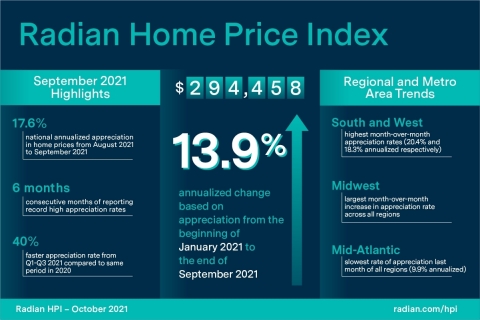Don’t Look Now, Home Prices Continued their Ascension, Radian Home Price Index Reveals
Nine months into 2021, home prices across

Radian Home Price Index (HPI) Infographic
The Radian HPI has risen at an annualized rate of 13.9 percent over the nine-month period (January to
“Given the rapid rise in home prices over a relatively short period of time, the Radian HPI is constantly mining the data to find signs of a shift in current housing strength--and so far, it seems to be heading in one direction,” noted
NATIONAL DATA AND TRENDS
-
Median estimated home price in the
U.S. rose to$294,488 - Sales represent a high percentage of listings
Nationally, the median estimated price for single-family and condominium homes rose to
The number of homes for sale fell from August to September. However, while falling listing counts is not uncommon in the
REGIONAL DATA AND TRENDS
- All Regions reported faster appreciation rates than prior month
- South and West show the strongest overall appreciation rates for the third straight month
In September, all six Regional indices recorded higher annual home price appreciation rates than the prior month. The South and West regions recorded the strongest annualized one-month appreciation rates for the third consecutive month (20.4 and 18.3 percent respectively). While the South and West recorded the highest overall appreciation rates, the Midwest reported the largest month over month increase in appreciation rate at 242 basis points higher than the prior month (16.2 vs. 13.8 percent). Of note, September has been the month with the fastest, annualized one-month appreciation rate for both 2020 and 2021, the pandemic years.
Over the last year, the Mid-Atlantic region has posted the slowest appreciation rate of all regions (9.9 percent) and was the only region to report a slower appreciation rate in
Home prices continue to be supported by a lack of supply. Months of Supply, which is measured as the current month’s active listings divided by last month's sales, fell last month and settled at 2.71 months. This was the fourth lowest ratio on record and only slightly higher than the all-time record low ratio of 2.49 months measured in January of this year.
METROPOLITAN AREA DATA AND TRENDS
- Appreciation rates rise in a majority of largest metro areas
- Large cities are becoming less affordable faster than smaller cities
Among the 20-largest metropolitan areas of the
Appreciation rates have been strong broadly across metro markets. Whether higher priced or lower priced, homes are appreciating at largely, similar rates. As such, when comparing appreciation by median home price level, the difference between the median price in the most expensive and least expensive housing market has widened over the past few years.
ABOUT THE RADIAN HPI
Additional content on the housing market can also be found on the Radian Insights page located at https://radian.com/news-and-knowledge/insights.
Red Bell offers the Radian HPI data set along with a client access portal for content visualization and data extraction. The engine behind the Radian HPI has created more than 100,000 unique data series, which are updated on a monthly basis.
The Radian HPI Portal is a self-service data and visualization platform that contains a library of thousands of high-value indices based on both geographic dimensions as well as by market, or property attributes. The platform provides monthly updated access to nine different geographic dimensions, from the national level down to zip codes. In addition, the Radian HPI provides unique insights into market changes, conditions and strength across multiple property attributes, including bedroom count and livable square footage. To help enhance customers’ understanding of granular real estate markets, the library is expanded regularly to include more insightful indices.
In addition to the services offered by its Red Bell subsidiary, Radian is ensuring the American dream of homeownership responsibly and sustainably through products and services that include industry-leading mortgage insurance and a comprehensive suite of mortgage, risk, title, valuation, asset management and other real estate services. The company is powered by technology, informed by data and driven to deliver new and better ways to transact and manage risk.
Visit http://www.radian.com to see how Radian is shaping the future of mortgage and real estate services.
View source version on businesswire.com: https://www.businesswire.com/news/home/20211103006224/en/
For Investors
Email: john.damian@radian.com
For the Media
Email: rashi.iyer@radian.com
Source: Radian







